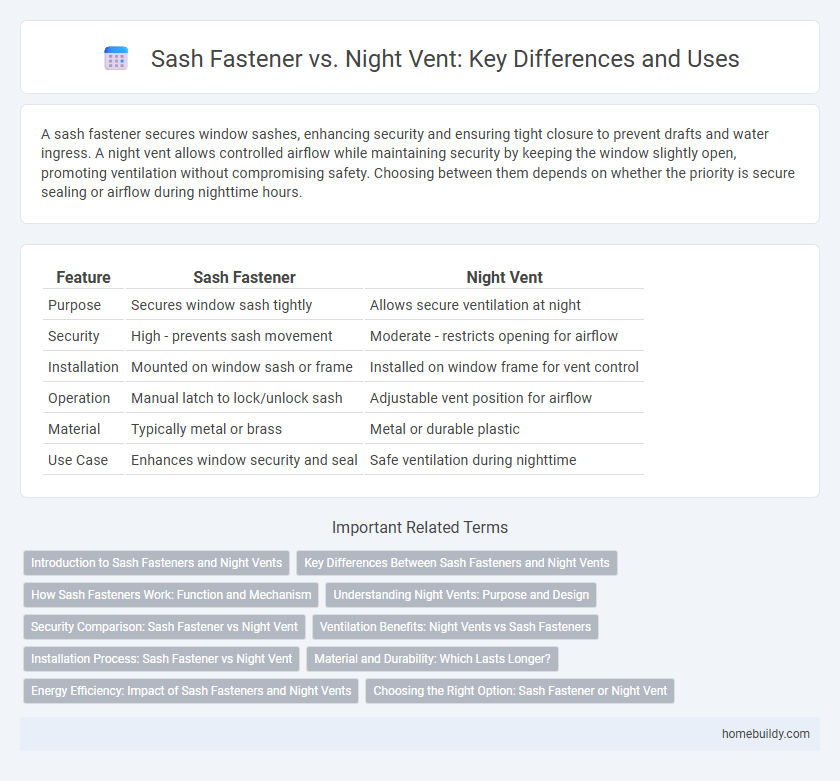A sash fastener secures window sashes, enhancing security and ensuring tight closure to prevent drafts and water ingress. A night vent allows controlled airflow while maintaining security by keeping the window slightly open, promoting ventilation without compromising safety. Choosing between them depends on whether the priority is secure sealing or airflow during nighttime hours.
Table of Comparison
| Feature | Sash Fastener | Night Vent |
|---|---|---|
| Purpose | Secures window sash tightly | Allows secure ventilation at night |
| Security | High - prevents sash movement | Moderate - restricts opening for airflow |
| Installation | Mounted on window sash or frame | Installed on window frame for vent control |
| Operation | Manual latch to lock/unlock sash | Adjustable vent position for airflow |
| Material | Typically metal or brass | Metal or durable plastic |
| Use Case | Enhances window security and seal | Safe ventilation during nighttime |
Introduction to Sash Fasteners and Night Vents
Sash fasteners secure window sashes by locking them in place, enhancing security and weatherproofing. Night vents offer controlled, minimal opening for ventilation while maintaining safety and preventing intrusions. Both features improve window functionality but serve distinct purposes: sash fasteners prioritize locking strength, while night vents focus on airflow management.
Key Differences Between Sash Fasteners and Night Vents
Sash fasteners secure window sashes firmly, enhancing security and weatherproofing by preventing sash movement, whereas night vents allow controlled airflow while maintaining some level of security through restricted opening. Unlike sash fasteners, which lock the window fully, night vents provide partial opening for ventilation without significant exposure to external elements or intruders. The choice depends on whether the priority is maximum security with airtight sealing or balanced ventilation with moderate security.
How Sash Fasteners Work: Function and Mechanism
Sash fasteners secure window sashes by pulling them tightly together, using a metal catch and lever mechanism that locks the window in place for enhanced security and weatherproofing. Unlike night vents that maintain a slight gap for ventilation while preventing forced entry, sash fasteners fully close and lock the window, ensuring maximum airtightness and safety. The mechanism typically involves rotating handles that engage with a catch or keep, providing a firm seal and convenient operation.
Understanding Night Vents: Purpose and Design
Night vents are designed to provide secure ventilation while maintaining home safety, featuring a small opening that allows fresh air into a room without compromising security. Unlike sash fasteners, which primarily secure windows by locking sash frames together, night vents focus on controlled airflow and protection against intruders. Their design incorporates durable materials and tamper-resistant mechanisms optimized for safe nighttime use, distinguishing them from the traditional function of sash fasteners.
Security Comparison: Sash Fastener vs Night Vent
Sash fasteners provide robust security by firmly locking windows in place, preventing unauthorized entry more effectively than night vents. Night vents allow partial window opening for ventilation but compromise overall security due to limited locking capabilities. For enhanced protection against break-ins, sash fasteners are the preferred choice over night vent options.
Ventilation Benefits: Night Vents vs Sash Fasteners
Night vents provide superior ventilation benefits compared to sash fasteners by allowing consistent airflow while maintaining security during nighttime hours. Unlike sash fasteners, which primarily secure windows without dedicated ventilation channels, night vents are designed to enable controlled air exchange, reducing condensation and enhancing indoor air quality. This functionality makes night vents more effective in promoting fresh air circulation without compromising window security.
Installation Process: Sash Fastener vs Night Vent
The installation process for sash fasteners typically involves drilling holes and securing the fastener to the window frame, which provides a robust and secure locking mechanism for sash windows. Night vents, designed for ventilation while maintaining security, often require less invasive installation, usually fitting into existing window slots or frames without extensive drilling. Choosing between the two depends on the desired balance of security, ease of installation, and ventilation needs, with sash fasteners offering a more permanent solution and night vents providing simpler, non-destructive installation.
Material and Durability: Which Lasts Longer?
Sash fasteners are typically made of high-quality metals like stainless steel or brass, offering robust durability and resistance to corrosion, which ensures long-lasting security for windows. Night vents often incorporate similar metals but may include additional components prone to wear due to constant adjusting and exposure to outdoor elements. In terms of material and longevity, sash fasteners generally outlast night vents due to their simpler design and use of more resilient metals that withstand weathering and frequent use.
Energy Efficiency: Impact of Sash Fasteners and Night Vents
Sash fasteners enhance energy efficiency by creating a secure seal that minimizes air leakage, reducing heat loss and improving insulation in windows. Night vents allow controlled ventilation without fully opening the window, balancing fresh air flow with maintaining indoor temperature stability. Choosing the right sash fastener or night vent directly affects energy consumption and thermal comfort in residential and commercial buildings.
Choosing the Right Option: Sash Fastener or Night Vent
Sash fasteners provide robust security and sleek design for securing windows firmly, ideal for homes requiring tight locking mechanisms. Night vents offer controlled ventilation while maintaining safety, perfect for allowing airflow without fully opening the window. Choosing between sash fasteners and night vents depends on balancing security needs with the desire for ventilation and ease of use.
Sash fastener vs Night vent Infographic

 homebuildy.com
homebuildy.com